Modular: A First Look at Elite Dangerous Role Playing Game
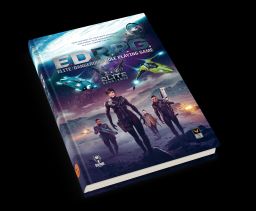
Yes, you read that right!
Elite Dangerous, the current incarnation of the granddaddy of all immersive video games, now has its own tabletop roleplaying game, and I’m sitting here with a review copy.
The problem with the video game is that, even with the new ability to land on airless worlds and trundle around in AFVs, it’s essentially space exploration on the radio. You don’t get to land on the worlds with interesting cultures and brawl with gangsters or tread the mean streets, or avoid being the main course at a barbaric religious ceremony. A tabletop roleplaying game has the potential to supply those missing experiences. But does the franchise really need its own game? (As you’ll see, “Yes, actually.”)
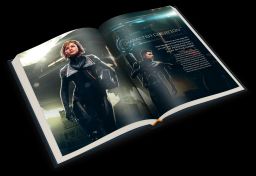
Frankly, I half-expected Elite Dangerous Role Playing Game (EDRPG) to be a cynically put together I can’t believe it’s not Traveller-lite (please don’t send round lawyers with pulse lasers) with a detailed trade mini-game. Instead I found myself reading what’s clearly a labor of love that emulates a different corner of the Star Punk genre, and does so with an emphasis — in the core rules — on what you do when you’re not trading. It’s also loaded with material pitched for beginner GM’s, but — again in the core rules — assumes some familiarity with the computer game; not disastrous, but confusing if you haven’t played Elite seriously in four decades (I’m told there will be free material on the website to help with this).
Given Elite Dangerous has 2-3 million players, and a cult of enthusiasts who enjoy the “shared” part of “shared escapism,” Elite Dangerous Roleplaying Game promises to be an instant modern classic. It’s a good thing, then, that the game mechanics are elegant, but more refined than innovative, which is what you want in something obviously intended as a workhorse to support happy years of sandbox gaming.
Let me unpack some of that.
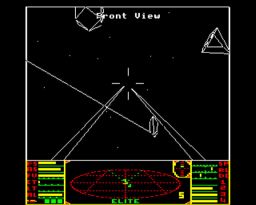
You had to be there, in the 1980s, to understand how mind blowing the original Elite was. It was the first computer game that lived up to the promise of computers. Instead of chunky sprites hopping around a 2D board, we had a 3D simulation in which we could explore a galaxy, trading and bounty hunting as we went. Even then, we knew that’s how computer games were supposed to be.
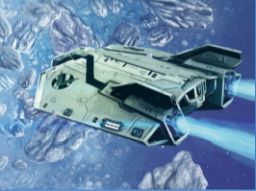
Better yet, this was at a time when Star Wars loomed large in our imaginations, when Hitchhiker’s Guide to the Galaxy was on TV and out in book form (“Space, it’s big…”), and when at least some of us were grappling with the now classic version of Traveller. Here was a game that not only emulated the experience of all that, but — even in primitive wireframe graphics — captured some of the aesthetics. Many of us spent long hours trying to get close enough to blast little white dots that would resolve into polyhedral pirate ships, and striving not to crash when docking with the revolving space station.
In his introduction, Oliver Hulme, the Lead Writer, identifies himself as just such a child; old enough to be gripped by the game, young enough to weave the game into wider make-believe play. And, of course, a child who embraced tabletop roleplaying as a way to carry his imagination with him into adulthood.
So at the helm of this game we have a lifelong Elite fan and tabletop roleplayer. Clearly it’s not going to be something somebody knocked off to make a quick buck.
Though Elite Dangerous shares Star Punk DNA with both Traveller and Starfinder, it has a very different vibe.
For a start, the — call it — galactic geography and ship technology combine to offer different choices to the players.
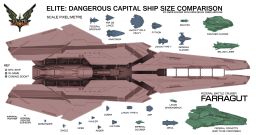
In Traveller you crawl across a vast universe one jump at a time, worrying about missjumps, upkeep costs and the expenditure of time itself. You’re so small, the universe is so big, that you can get away with 2D star charts. A dozen worlds in one subsector will keep you in adventures for years. There’s galactic geography, but limited destinations. The resulting weird blend of agoraphobia and claustrophobia beautifully captures the feel of writers such as EC Tubb and H Beam Piper.
In Starfinder, you skip around the vast universe the way we surf the web. You just need an address. Though it’s possible for something nasty to travel sub-light between neighboring stars, from the player point of view, there’s no real galactic geography but almost infinite possible destinations. This is the vibe of Star Wars and countless swashbuckling Space Operas, such as Simon R Green’s Deathstalker series.
In Elite Dangerous RPG, as in the video game, you can take your reliable ship anywhere in the galaxy, jumping between systems the way, back in the 1930s, a flying boat might island hop across the Pacific. The only real worry is fuel, and there are fuel scoops to help with that. So there is galactic geography but there is also unlimited choice of destination as long as you can weather the journey. This is closer to the way a lot of modern Space Opera works, but also classics like Flinx. (And also, ahem, my own Eternal Dome series.)

Did I mention a flying boat? That’s the other thing that’s very different. Whereas Traveller and Starfinder see spacecraft as analogous to modern surface ships, with different classes ranging in size from launch through to mega freighter, each with its own deckplans, the space ships of EDRPG are more like the aeroplanes of the 1930s: cockpit plus a few crew stations, with a bunk room if you’re lucky, all perched above a hold. Yes, there are large EDRPG ships. The Anaconda, for example, is about the size of a WWII Light Cruiser. However, mostly, we’re a long way from state rooms and engineering compartments.
Browsing them, the first thing that popped into my mind was the interwar Biggles stories where the burned out ex fighter pilots contract their way around South American in a Vandal flying boat. Or perhaps that odd Disney TailSpin series that went out in the 1990s. Or even the small ships that sputter across the old Buster Crab Flash Gordon serials.
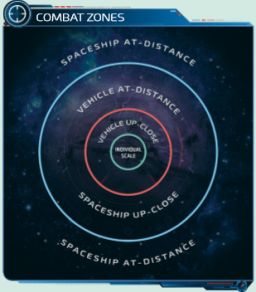
And, looking at the character generation and adventure seeds, that’s pretty much the genre that EDRPG is built to emulate. Everybody starts with a spaceship, nobody worries about maintenance except where it generates plot. Yes it’s a bit like Traveller, but with less grit baked into the bookkeeping and — thanks in part to a point driven stunt system — more swashbuckling. It’s not narrativist, but it’s more genre emulation than simulation. (Though you could argue that Traveller itself is an emulation of a simulation…)
Though you do track money, surprisingly, one thing it’s not really about is trading! Rather, it’s about the adventures you have when you are trading (or bounty hunting or whatever). In this it vaguely recalls Fate Diaspora‘s stubborn insistence on abstracting the whole business of ship owning. In the EDRPG core rules, you can roleplay trade. There’s a table of goods with indications of where they’re produced, and where demanded. However it’s up to the GM to set prices based on the range indicated. This is really not a mini-game! (Though I believe a forthcoming trade supplement will fill this gap.)
What is a mini-game is what you do between adventures. Essentially, you pick from activities like Safe Trading through to Bounty Hunting, and role dice to see what happened to you or your employee. It’s a big galaxy! You can indeed turn up for the next adventure without your ship…
Which leads me to one of the things I really like about EDRPG. It has a good grip on scope both in terms of time — we see that with the between adventures rules — and tactical space. A lot of games sort of do this, but EDRPG explicitly sets out the relationship between different scopes of combat: Space Combat wraps around Vehicle Combat, both with abstracted movement. Vehicle combat wraps around Infantry Combat, which is a more traditional measure and move affair. Where the vehicles intersect with the infantry, they appear on the table as any other figure.
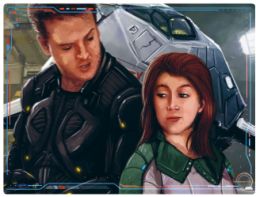
As a GM I can immediately see the strength of this. Up in orbit, the pilot can dogfight the pirates, while down below, battling vehicles rampage across the surface encountering random obstacles, while those on foot hole up in alien ruins, exchanging beams and bullets with skirmishing pirates. Every so often, a ship drops out of orbit to exchange fire with a vehicle or strafe the footsloggers. Whoever wins the vehicle battle will trundle into the firefight guns blazing.
This is good stuff.
Which leads me to mechanics.
It’s a D10 system: Skill + D10 to beat a target number. The specifics offer no surprises. The rules follow tried and tested forms. I flinch at having different range bands and bonuses for each ranged weapon, but only having a single dice to roll should compensate a bit for this. Vehicle and Space combat rely on abstracted movement — basically pick close or long range — and promise to be smooth enough to be fun activities in their own right.
Though you are not married to them, everything is optimised to support four kinds of mission: Exploration, Espionage, Military and Lone Wolf, with the action as likely to take place in space as on the ground, and be just as easy to play. Mechanically, your spaceship is just another load out.
You’ll notice I didn’t mention Stat bonuses. That’s because there are no stats! In common with FATE games, your character is built mostly of skills and you have to infer the rest. That means abilities lack that sense of narrative: “I’m big and strong and good with an axe”. However it’s simple, as is the advancement system. Ability scores are double digit (divide by 10 for the bonus). You tick any skill used during an adventure. At the end you get points to advance it. You also get more points when you level up, from — you guessed it — from Harmless through to Elite.
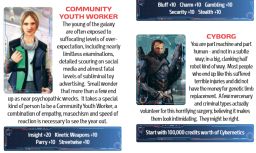
Which brings us to character generation.
You build your character by picking, randomly or otherwise, four backgrounds. The selection ranges from boring — Teacher — through swashbuckling — Freedom Fighter — to zany — Computer Game Designer. That’s where your initial skill points come from. If you select “Partner” then you get a randomly generated NPC as a buddy — handy for those two-crew craft. Though in game mechanics they’re symbiotic with you — you can even use your Karma Points to help them out — you can’t take them for granted in roleplay. The dice can land you with anything from a domineering spouse, through an annoyed fellow pilot whose ship you wrecked, to a dependent child!
Finally, there are the usual equipment lists, fairly lite rules for generating planetary systems (I believe there will soon be a free app for this), lots of NPCs and monsters to interact with, backgrounds on the various factions — all well-written, by the way — and deviously inventive random adventure tables. There’s also heaps of good advice for the novice GM, and advice on different play styles and how to set up different kinds of adventures. Oh and the illustrations are good, and the writing is clear and lively — except for the alphabetised list of goods, this is all effective technical communication.
Only two things are really missing.
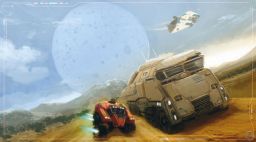
First, there are no star charts or any guidance on how to lay them out. The game just implicitly assumes you’ll use some of the fan-based material online, or know what they should look like because you are a veteran Elite Dangerous player. For me that’s a bit of an omission! (Understatement.) However I am told there will shortly be more material on their website to make up for this.
Second, like the Traveller Core Rulebook, there’s no index. What is it with games designers? I guess they’re assuming you’ll have the PDF, which you’ll probably want for printing off tables of equipment lists anyway (mercifully, the design has a plain white background, so you can print or photocopy sections in order to make your own GM’s screen/reference sheets).
Overall then, Elite Dangerous Role Playing Game core rule book presents a good, mostly self-contained set of science fiction rules, though I suspect that anybody playing it for any length of time will want to buy the supplements as they come out.
If you are an Elite Dangerous fan, then this is the roleplaying game for you: it does what it says on the tin, and you’re quite able to supply anything missing to the mix. Buy it. Play it. Post a nice review somewhere.
If you are primarily a tabletop roleplayer looking for a space adventure game, then it depends on the feel you want to achieve, where you want the focus. Assuming Science Fantasy isn’t your bag, then you have a choice between EDRPG or Traveller. They emulate slightly different sub (sub?) genres. Traveller has more detailed rules but with the conflict baked in. EDRPG offers you more creative freedom. It also has easier and simpler space travel, basically with the fudging GMs do already included. If you want to do John Steinbeck in Space, with your players basically counting grit while trying not to get killed (more fun than it sounds), then Traveller’s your vehicle. If you want to do two-fisted pulp pilots in space, then get Elite Dangerous Roleplaying Game.
Would I/will I GM it, given that I’m already building up experience and my own universe with Traveller?
Yes, when I want to run an adventure with the whole galaxy as a playground, perhaps the kind of game Edmond Hamilton might have run had he not lived in the dark ages before polyhedral dice. If so, I’ll do it in my own setting. We’ll see…
M Harold Page is the Scottish author of The Wreck of the Marissa (Book 1 of the Eternal Dome of the Unknowable Series), an old-school space adventure yarn about a retired mercenary-turned-archaeologist dealing… decisively with “local difficulties” as he pursues his quest across the galaxy.